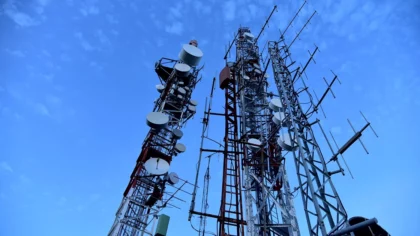Accelerate Productivity in 2025
Reignite Growth Despite the Global Slowdown
5G is up to 100 times faster than 4G, enabling faster connectivity, ultra-low latency, concurrent connectivity, and greater bandwidth. This transformative potential is leading to significant momentum in 5G adoption.
From telecommunication operators, technology providers, and government bodies to cloud service providers and internet service providers (ISPs), industries are investing in 5G. The technology is expected to have a profound impact on diverse industries, with many 5G trends enabling new applications and business models.
These trends include open radio access networks (RAN), network slicing, beamforming, and more.
What are the trends in 5G?
- Open RAN
- Network Slicing
- Beamforming
- Standalone 5G Infrastructure
- Ultra-Reliable Low Latency Communications (URLLC)
- Phased Array Antennas
- Massive Machine-Type Communications (mMTC)
- Enhanced Mobile Broadband (eMBB)
- Carrier Aggregation
- Dynamic Spectrum Sharing (DSS)
Methodology: How We Created the 5G Trend Report
For our trend reports, we leverage our proprietary StartUs Insights Discovery Platform, covering 5M+ global startups, 20K technologies & trends plus 150M+ patents, news articles, and market reports.
Creating a report involves approximately 40 hours of analysis. We evaluate our own startup data and complement these insights with external research, including industry reports, news articles, and market analyses. This process enables us to identify the most impactful and innovative trends in the 5G industry.
For each trend, we select two exemplary startups that meet the following criteria:
- Relevance: Their product, technology, or solution aligns with the trend.
- Founding Year: Established between 2020 and 2025.
- Company Size: A maximum of 200 employees.
- Location: Specific geographic considerations.
This approach ensures our reports provide reliable, actionable insights into the 5G innovation ecosystem while highlighting startups driving technological advancements in the industry.
Innovation Map outlines the Top 10 5G Trends & 20 Promising Startups
For this in-depth research on the Top 5G Trends & Startups, we analyzed a sample of 1500+ global startups & scaleups. The 5G Innovation Map created from this data-driven research helps you improve strategic decision-making by giving you a comprehensive overview of the 5G industry trends & startups that impact your company.
Tree Map reveals the Impact of the Top 5G Technology Trends in 2025
Based on the 5G Innovation Map, the Tree Map below illustrates the impact of the Top 10 5G Industry Trends in 2025. Open RAN, or O-RAN, is a significant trend that emphasizes open and interoperable radio access networks. This fosters innovation and vendor diversity while network slicing allows the creation of virtualized, isolated slices within the network to cater to diverse applications. Additionally, beamforming enhances network efficiency and data rates while standalone 5G network infrastructure provides an independent architecture that maximizes the 5G capabilities.
Global Startup Heat Map covers 1541 5G Startups & Scaleups
The Global Startup Heat Map showcases the distribution of 1500+ exemplary startups and scaleups analyzed using the StartUs Insights Discovery Platform. It highlights high startup activity in the US and the UK, followed by India. From these, 20 promising startups are featured below, selected based on factors like founding year, location, and funding.
Want to Explore 5G Innovations & Trends?
Top 10 Global 5G Technology Trends in 2025
1. Open RAN
ORAN advocates open, interoperable standards that disrupt the traditional dominance of a few major players. This approach facilitates a more diverse vendor ecosystem, enhancing competition and innovation.
Central to ORAN is its software-centric nature, allowing for flexible, scalable networks crucial for the evolving demands of 5G services. It supports advanced concepts like network slicing and virtualization, enabling operators to create multiple virtual networks tailored to IoT, high-speed broadband, and more.
Additionally, Open RAN emphasizes the use of AI and ML for intelligent network management, optimizing performance and resource usage. This shift towards a more open and flexible network architecture promises cost efficiency and adaptability.
However, it also presents challenges in integration, security, and transitioning from traditional RAN architectures. ORAN’s influence in the 5G sector signifies a move towards more adaptable, efficient, and innovative network solutions, reshaping how networks are built and operated.
The open RAN Market size is expected to reach USD 19.58 billion by 2030, at a CAGR of 37.56% during the forecast period of 2025-2030.
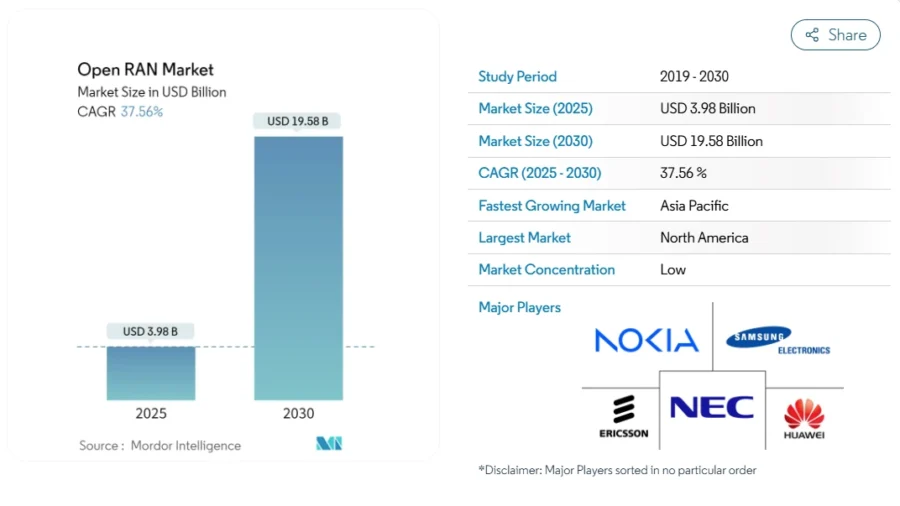
Credit: Mordor Intelligence
Firecell deploys Private 5G
Firecell is a French startup that provides cost-effective and user-friendly private 5G connectivity solutions for enterprises. It develops FlexRIC, a flexible RAN-intelligent controller, which is part of the O-RAN project group.
Firecell’s private 5G networks and turn-key 5G network solutions allow businesses to connect and track assets, vehicles, robots, sensors, smartphones, and more. This benefits industries like manufacturing, logistics, research, and defense.
Rimedo Labs supports Open RAN Scenario Experimenting
Rimedo Labs is a Polish startup that specializes in consulting, implementation, and R&D services for modern wireless systems, with a focus on 5G and O-RAN. Its open RAN xApp/rApp Demonstrator allows experimentation with two sample O-RAN scenarios.
The startup’s Traffic Steering xApp (TS-xApp) intelligently controls cell preferences and mobile handovers to improve radio resource utilization and meet users’ quality of service (QoS) demands. Telecom companies leverage the company’s solutions to improve network performance, cost savings, resilience, and scalability.
Open Valley builds Agile Scalable 5G Networks
Open Valley is an Egyptian startup focusing on open, disaggregated, intelligent, and cloud-native networks. Catering to mobile network operators, system integrators, and enterprises, the startup enables its clients to build agile, scalable, and cost-effective 5G networks.
It accelerates time-to-market for large-scale rollout by providing comprehensive testing strategies, test cases, detailed test procedures, and acceptance criteria. These solutions are also fully virtualized, containerized, and cloud-native, which integrate with various domain controllers.
2. Network Slicing
Unlike the traditional approach of a single, uniform network infrastructure, network slicing allows for the creation of multiple, distinct virtual networks over a shared physical infrastructure. This architecture is key to addressing the diverse and specific demands of 5G applications, ranging from ultra-reliable, low-latency connections to massive machine-to-machine (M2M) communications.
Network slicing’s modular nature allows for the tailoring of network segments to meet specific requirements of different applications or services. Further, it empowers 5G service providers to scale their networks flexibly and cost-effectively.
Providers can dynamically create new network slices based on demands, thus allocating resources efficiently to optimize network performance and user experience.
The global network slicing market size is projected to reach USD 43.83 billion by 2033, growing at a CAGR of 50.2% during the forecast period of 2025-2033.
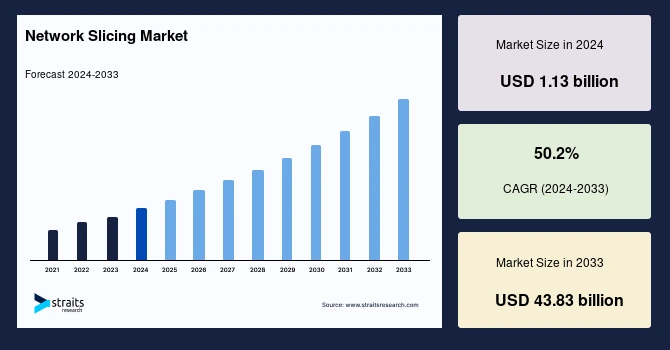
Credit: Straits Research
Fivecomm aids in Network Slice Orchestration
Spanish startup Fivecomm provides solutions for the management and orchestration of network slices, allowing operators to optimize their communication services. Fivecomm’s solutions demonstrate end-to-end and automated network slicing capabilities, integrating use cases and applications to provide efficient 5G network management.
The startup develops these 5G solutions for compliance tests, validation, and demonstration of its use cases. It has collaborated with Ericsson and Telefonica to demonstrate its network slicing capabilities using a 5G SA Release-16 infrastructure with network slicing capabilities.
Curated Networks facilitates Wireless Spectrum Sharing
Curated Network is a US-based startup that provides solutions for 5G communication systems, particularly in the area of network slicing. Its solutions enable the coexistence of different wireless technologies and optimize the use of available spectrum resources to accelerate 5G deployment.
The startup’s pre-configured, pre-integrated solutions enable the development of solutions that optimize the use of spectrum resources, reduce interference, and increase connectivity and capacity. They are used in a variety of industries, including manufacturing, logistics, research, and defense.
3. Beamforming
Beamforming focuses the wireless signal towards a specific receiving device, rather than spreading the signal in all directions as in traditional broadcasting methods. The primary advantage of beamforming in 5G networks is its ability to significantly improve signal strength and reduce interference. By directing the signal beam towards the intended user, this approach enhances the overall efficiency of the network, leading to faster data rates and more reliable connections. Therefore, it is beneficial in densely populated urban areas where the wireless spectrum is crowded.
Additionally, beamforming enables more efficient use of the available spectrum. In 5G networks, which operate on both traditional lower frequencies and new higher frequencies (such as millimeter waves), managing signal propagation is crucial.
Higher frequencies offer more bandwidth and faster data speeds but have shorter ranges and are more susceptible to obstructions. Beamforming addresses these challenges by precisely steering the signal to navigate around obstacles and reach the receiver with minimal loss.
The global beamformer market size is set to reach USD 569 345 million by 2031, with a CAGR of 16% from 2024 to 2031.
Anser Information Technologies supports Beamforming with AI Algorithms
Anser Information Technologies is a Turkish startup that develops 5G/6G enabling technology. Its reflecting intelligent surface (RIS) controller is programmed to control electromagnetic waves and develops algorithms for optimization and resource allocation. This improves the performance of beamforming technologies in 5G networks. The controller finds use in operations support systems and business support systems in telecom and the defense industries.
Saab RDS offers 5G Beamforming in Massive MIMO Systems
Saab RDS is a US-based startup that builds and orchestrates massive multiple-input multiple-output (MIMO) ecosystems to solve complex problems. The startup uses advanced modulation and beamforming techniques to achieve high data rates and low latency.
It also offers solutions to address the challenges associated with the design, prototype, and test stages in 5G and massive MIMO technologies, catering to the telecom and manufacturing industries.
4. Standalone 5G Infrastructure
5G standalone (SA) network infrastructure uses just a 5G core network without depending on 4G LTE network control functions. These networks leverage 5G infrastructure across both the radio access network (RAN) and the core network, coupled with cloud-native principles like virtualization, containers, and microservices. 5G SA networks are more flexible, scalable, and efficient in their use of network resources. They provide a better end-user experience and lower costs for wireless carriers.
Besides enhancing bandwidth, it supports URLCC, crucial for applications like autonomous vehicles, precision robotics, machine vision, and massive IoT. Standalone 5G also provides the ability to slice the network into customized virtual pieces to suit the specific needs of businesses while maximizing operational efficiency.
The global standalone 5G network market size was valued at USD 2.41 billion in 2024 and is projected to grow at a CAGR of 55.6% from 2025 to 2030.
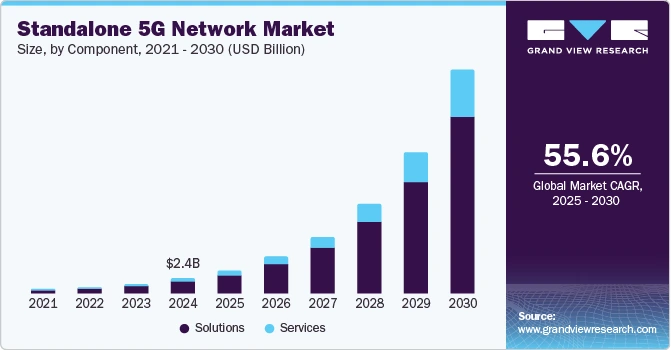
Credit: Grand View Research
SEMPRE builds Standalone 5G Networks
US-based startup SEMPRE creates standalone 5G network infrastructure that is fast, reliable, secure, and resilient. Its infrastructure features the SEMPRE Tower which combines a full 5G network with an edge data center.
The startup’s solution allows for maximum control of data and enables data processing closer to end-users. Sectors benefitting from SEMPRE’s standalone 5G infrastructure include power grids, hospitals, emergency first responders, and defense, among others.
Microamp Solutions develops Private Standalone Industrial 5G Networks
Microamp Solutions is a Polish startup that develops next-generation industrial networks based on 5G mmWave technology. Its private, standalone industrial 5G network infrastructure delivers seamless communication experiences and meets Industry 4.0 demands and needs.
It supports ultra-low latency, enhanced network slicing, improved network security, and, independent network operation. Enterprises and network providers leverage the startup’s solution to deploy private 5G networks with enhanced flexibility, scalability, and performance.
5. Ultra-Reliable Low Latency Communications
URLLC caters to critical scenarios such as autonomous vehicles, remote surgery, and industrial automation where real-time data is a minimum requirement. The underlying technologies enabling URLLC include advanced error correction mechanisms, network slicing, and edge computing.
Error correction ensures data integrity despite potential network disturbances while network slicing allows the creation of dedicated virtual networks with guaranteed quality of service. This ensures priority is given to latency-sensitive applications.
Edge computing plays a significant role by processing data closer to the end-user, drastically reducing response times. Together, these technologies contribute to URLLC’s ability to deliver highly reliable connectivity with latencies as low as a few milliseconds, a game-changer for real-time, critical applications in the 5G era.
The URLLC market size was valued at USD 3.6 Billion in 2022 and is projected to reach USD 18.4 Billion by 2030, growing at a CAGR of 22.6% from 2024 to 2030.
Genesis Codes provides URLLC Encoding and Decoding Algorithms
Genesis Codes is a US-based startup that offers URLLC network solutions for 5G and network error correction solutions. The startup focuses on channel coding techniques for short block lengths and develops novel data coding and compression algorithms. Its algorithm also supports both encoding and decoding. Genesis Codes’ 5G URLLC solution enables the design of efficient and reliable communication systems for applications like telesurgery, factory automation, and IoT.
Enquantum accelerates commercial cloud communication systems
Equantum is an Israeli startup that offers field-programmable gate array (FPGA) as a service for URLLC in 5G networks. This solution is particularly adept at enhancing commercial cloud communication systems, introducing a novel approach to cryptography suited for the demands of 5G and future network technologies.
It also mitigates risks, boosts capabilities, and heightens efficiency, all while maintaining low power consumption, a compact physical size, and minimal heat generation. The solution supports various applications, including mission-critical IoT applications, vehicle-to-everything (V2X), industrial IoT, and medical applications.

6. Phased Array Antennas
Phased array antennas are emerging as a crucial trend in 5G technology, offering significant improvements in signal strength, gain, directivity, and bandwidth performance. These antennas control the direction of the emitted beam through the interference of signals from multiple emitters. When these signals are perfectly in phase, they constructively interfere, creating a stronger signal in a specific direction.
In 5G, phased array antennas are essential for exploiting the millimeter-wave spectrum. Hence, they are essential to achieve wider bandwidths, extensive coverage, and greater network capacity.
These antennas support the high transmission rates, enhanced gain, and reduced latency that 5G demands. The ability to precisely direct signals further aids in addressing the challenges posed by the higher frequencies used in 5G, such as shorter range and susceptibility to physical obstructions.
The phased array antenna market size was valued at USD 3.64 billion in 2021 and is expected to reach USD 10.69 billion by 2031, at a CAGR of 11.49%.
Circuits Integrated offers Phased Array Antennas for 5G
Circuits Integrated is a Greek startup that develops solutions and products for satellite communication, 5G, and IoT. It utilizes designs in various silicon technologies for beamforming and other telecom applications, also supporting IC developments from concept to production. For example, its monolithic microwave-integrated circuits (MMICs) upgrade the performance of low-power, high-efficiency NextG antennas. The startup’s chips are used in high-frequency, high-power, and low-noise applications impacting several industries and applications.
Dujud makes 3D Phased Array Antenna Technology
US-based Dujud develops 3D phased array antenna technology for emerging extremely high-frequency (mmWave) radar and telecommunication systems. The startup allows satcom companies to use phased-array antennas in 5G systems to improve signal strength, gain, directivity, and bandwidth performance. This significantly increases channel density for populated areas while reducing the required number of satellites to operate a network, reducing the total cost of ownership. Dujud’s technology thus aids the integration of high-power front-end electronics and the manufacturing of large-scale arrays of micron-sized resolution antennas.
7. Massive Machine-Type Communications
mMTC caters to the rapidly growing IoT sector by supporting an enormous number of devices transmitting small, sporadic data packets. As a fundamental service category in 5G, mMTC accommodates a vast array of low-power, low-complexity devices, often transmitting small amounts of data intermittently. This service is crucial for scalable connectivity in massive IoT deployments, making it a cornerstone of 5G’s IoT strategy.
mMTC also supports connection densities of up to one million devices per square kilometer, surpassing 4G LTE capabilities. This is pivotal for applications in smart cities, industrial automation, and smart homes, where thousands of interconnected devices operate simultaneously.
Moreover, mMTC is optimized for handling small data packets and is primarily uplink-centric, meaning it efficiently manages data transmitted from numerous devices to a central server, rather than focusing on downlink data flow.
The massive machine type communication market is expected to reach USD 4.43 billion by 2030, at a CAGR of 9.42% during the forecast period of 2025-2030.
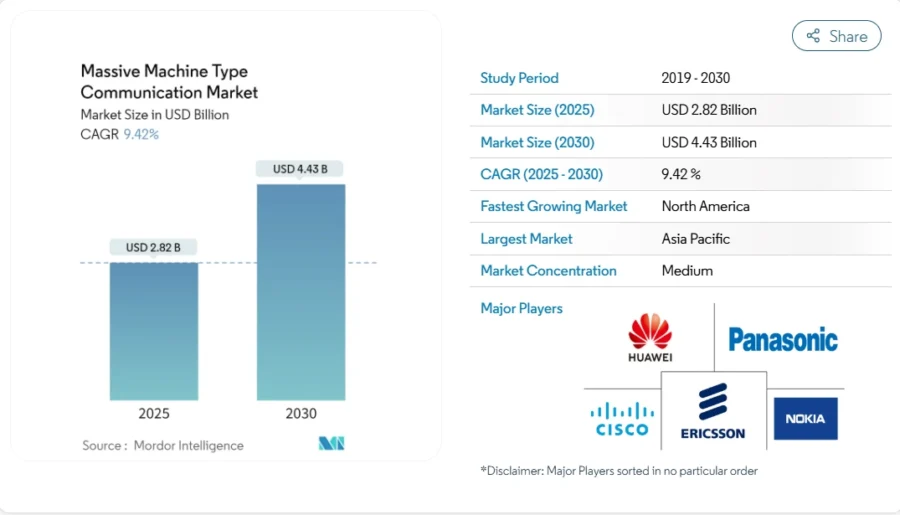
Credit: Mordor Intelligence
YunZhi Ruantong offers mMTC Chipsets
YunZhi Ruantong is a Chinese startup that specializes in mMTC. Its specialized chipsets feature low power consumption, high reliability, and efficient data transmission. YunZhi Ruantong’s specialized mMTC solutions are used in various industries such as smart cities, industrial automation, and agriculture.
Beijing Changkun Technology develops a 5G L1/L2/L3 Protocol Stack
Beijing Changkun Technology (BCT) is a Chinese startup that provides a 5G core network, 5G RAN, CPE (customer premises equipment), network management, and other solutions. The startup develops a 5G L1/L2/L3 protocol stack and low power consumption 5G solutions. BCT’s 5G Smart Park solution incorporates an integrated 5G base station and customized industrial CPE terminal. This allows operators to build private 5G networks to fully utilize spectrum resources and expand 5G industry applications.
8. Enhanced Mobile Broadband
eMBB delivers higher data rates, improved bandwidth, increased reliability, and reduced latency.
This 5G service category is a significant leap from the traditional 4G LTE networks, embracing a more sophisticated 5G core network to enable a versatile and advanced mobile network architecture.
It is crucial for meeting the demanding system requirements of modern wireless networks and plays a vital role in supporting large-scale IoT implementations and mission-critical projects across industries.
A standout feature of 5G eMBB is its ability to provide reliable indoor connectivity, ensuring a consistent and high-quality user experience even in densely populated areas. It also guarantees extensive network coverage and real-time communication to maintain connectivity in dynamic environments such as moving vehicles.
eMBB facilitates applications that demand high data throughput and low latency, like high-definition video streaming, real-time gaming, and immersive AR and VR experiences.
The enhanced mobile broadband (eMBB) service market size is projected to reach USD 26.58 Billion by 2030, growing at a CAGR of 60.16% during the forecasted period 2024 to 2030.
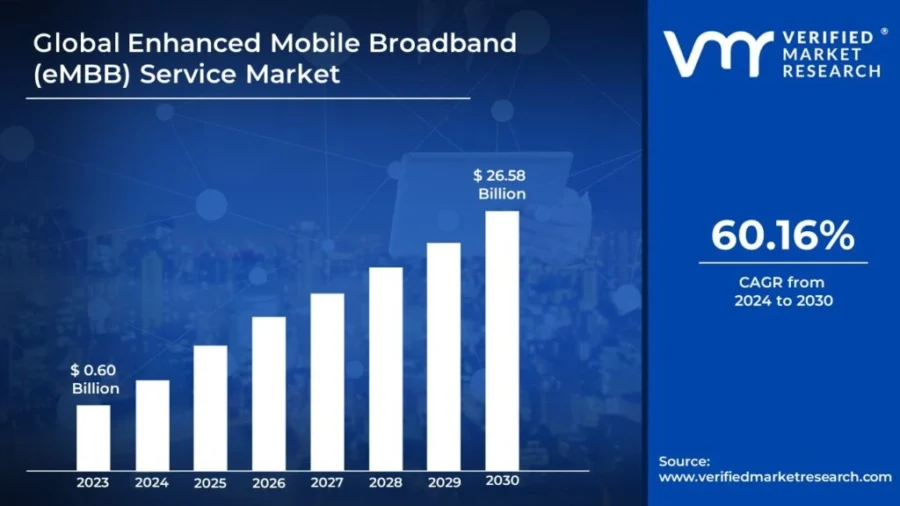
Credit: Verified Market Research
Tekdis LLC provides Reliable and Secure 5G Connectivity
Tekdis is a US-based startup that offers computing, display, and RF solutions to various markets. It offers a range of products, including 5G/LTE gateways and RF solutions, that optimize the eMBB experience for businesses.
These products enable real-time data acquisition, remote monitoring and control, industrial automation, and secure connectivity in various industrial applications. Tekdis’ products are used in the manufacturing, transportation, oil, gas, mining, and healthcare industries.
Genevisio makes a 5G User Plane Function (UPF) Acceleration Card
Genevisio is a Taiwanese startup that offers a 5G UPF accelerator card. It features low latency and high throughput, delivering enhanced speed and volume in data processing. Further, the card enhances mobile broadband experiences and supports different verticals like virtual reality (VR), IoT, automotive, and healthcare.
9. Carrier Aggregation
Carrier aggregation enhances network performance by allowing the simultaneous use of multiple frequency bands. This significantly increases data rates, improves network capacity, and extends coverage. In 5G networks, carrier aggregation enables mobile operators to combine the capabilities of radio cells operating on different frequency allocations, thereby elevating the user experience. Initially a feature in 4G networks, it has now been adapted and extended in 5G networks as a key software functionality in both radio access networks and user devices.
A critical advantage of carrier aggregation in 5G is the transformation of the combined spectrum bandwidth from various allocations into substantially higher data rates for users. It provides expanded bandwidth and reduced latency, leading to improved network capacity and performance. Additionally, carrier aggregation ensures efficient management of multiple carriers and offers enhanced network coverage. This technology is vital for the swift rollout of 5G networks, as it allows for more effective utilization of available spectrum resources.
The carrier aggregation solution market is projected to grow from USD 27.79 Billion in 2025 to USD 125.58 Billion by 2034 at a CAGR of 18.24% during the forecast period (2025 – 2034).
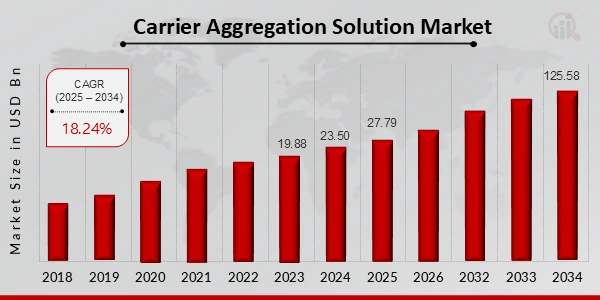
Credit: Market Research Future
Aira Technologies aids Dynamic Radio Network Management
Aira Technologies is a US-based startup that provides carrier aggregation solutions. They allow mobile network operators (MNOs) to combine multiple frequency bands and increase the data speeds and capacity of their networks to ensure efficient use of wireless resources. Aira also offers a machine learning-based dynamic radio network management application to drive energy efficiency for 4G and 5G networks.
Aira Technologies’ solutions improve channel estimation, prediction, and beam management, delivering significant throughput enhancement. They also improve network performance and spectral efficiency as well as boost mobile wireless performance. This enables network providers to optimize their networks for faster data speeds, better network capacity, and improved connectivity.
SynMatrix Technologies aids RF Filter Design
SynMatrix Technologies is a Canadian startup that provides design and test measurement tools for RF passive components. The startup provides a cloud-based component design platform for RF engineers and technicians to accelerate the microwave component design and manufacturing process. It also offers a comprehensive feature set, including arbitrary coupling matrix synthesis, performance optimization, and topology analysis.
Telecom companies use Synmatrix’s platform to design and optimize RF filters for carrier aggregation systems and other applications. The solution allows engineers to overcome challenges such as miniaturization, and the wide application of usage and frequency ranges in front-end wireless communication systems.
10. Dynamic Spectrum Sharing
DSS is a strategic approach for communication providers to optimize their spectrum usage. DSS facilitates the concurrent operation of 4G LTE and 5G services within the same frequency band. This is achieved by dynamically allocating bandwidth between 4G and 5G users based on real-time demand. As a result, DSS serves as a critical accelerator for the deployment of 5G networks, enabling operators to efficiently cater to both 4G and 5G users on their existing spectrum infrastructure without extensive physical upgrades.
One of the key advantages of DSS in 5G networks is its ability to enhance overall network efficiency through the dynamic distribution of spectrum resources. This flexibility allows for the synchronization of spectrum usage among multiple users, thereby minimizing interference and optimizing bandwidth allocation.
Consequently, DSS contributes to improved network coverage and higher data rates, while also reducing latency. Further, this technology offers significant cost savings by leveraging existing infrastructure, making the transition to 5G more economical for operators.
Spectranomy facilitates Spectrum Management
Spectranomy is a US-based startup that develops and deploys DSS technologies. Its spectrum management platform leverages real-time data analysis and AI for real-time spectrum analysis, dynamic spectrum allocation, and secure and reliable sharing. The platform also provides real-time information about the national wireless spectrum that is under-utilized. This allows businesses to identify idle bandwidth that can be repurposed, increasing spectrum availability, network performance, and cost-savings.
Discover all 5G Trends, Technologies & Startups
The rapid evolution and uptake of 5G technology promises an unprecedented era of connectivity and innovation. With the implementation of Open RAN, network slicing, and URLLC, 5G is set to revolutionize diverse industries, from autonomous vehicles to IoT deployments. The expansion of carrier aggregation and dynamic spectrum sharing further enhances efficiency. In this transformative landscape, the future, driven by innovative trends, holds possibilities for seamless, high-speed connectivity. The 5G Trends & Startups outlined in this report only scratch the surface of trends that we identified during our data-driven innovation & startup scouting process. Identifying new opportunities & emerging technologies to implement into your business goes a long way in gaining a competitive advantage.


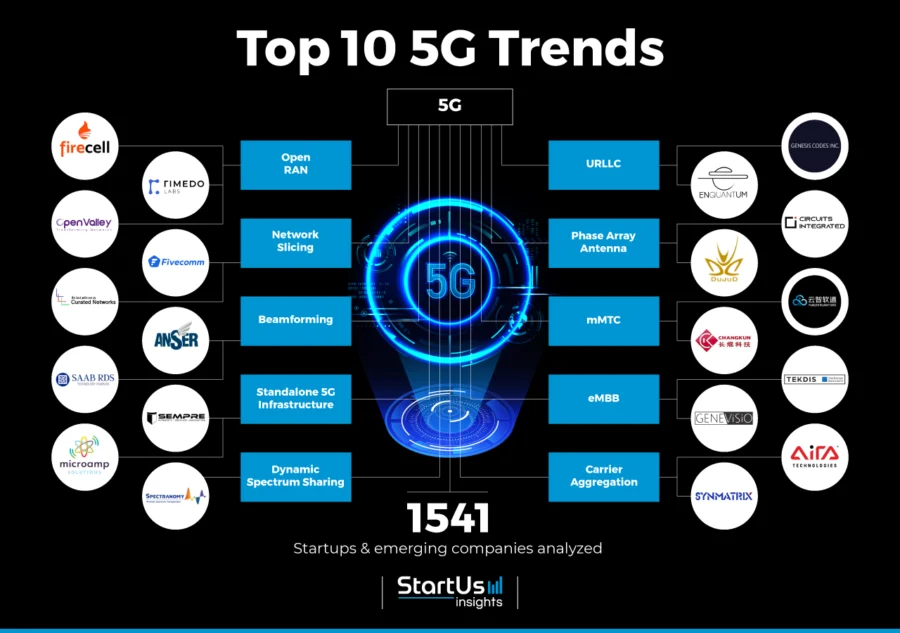
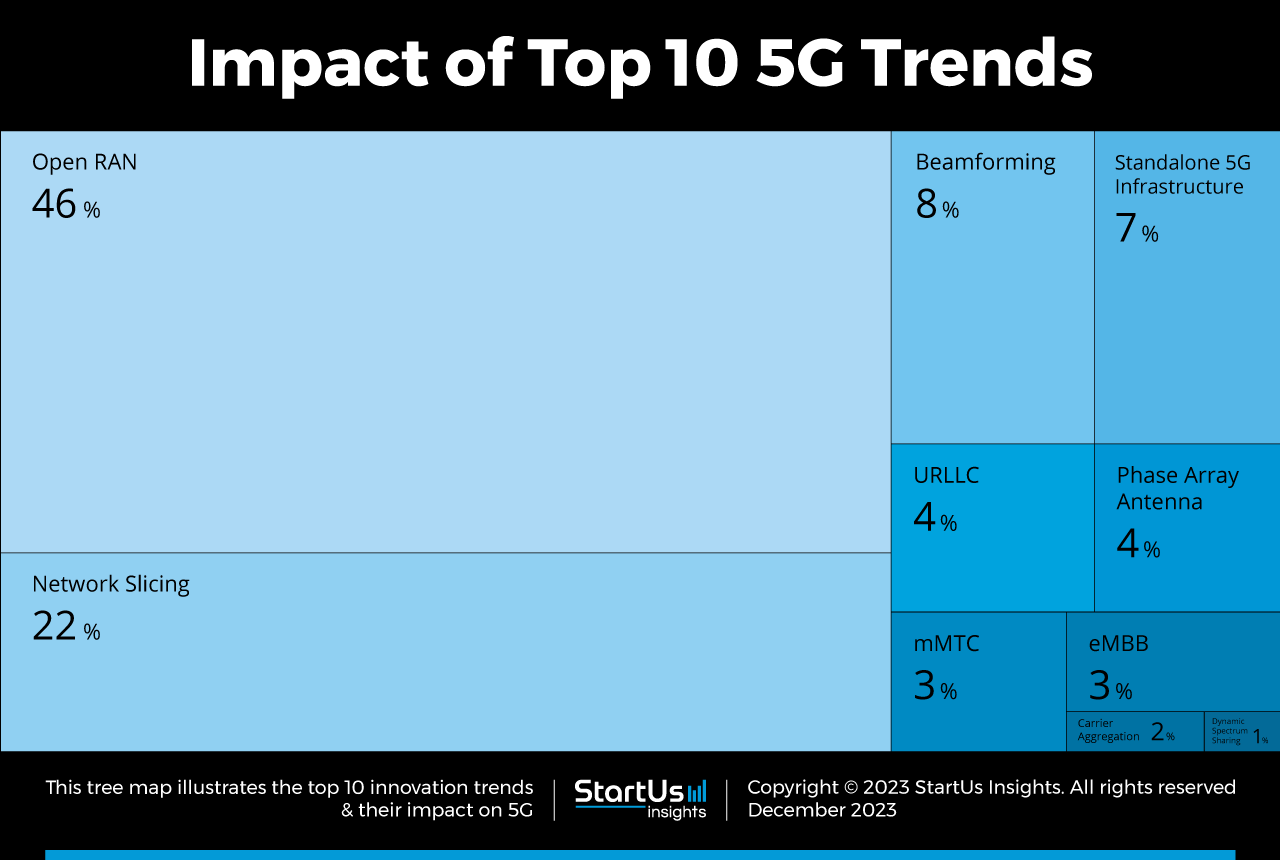
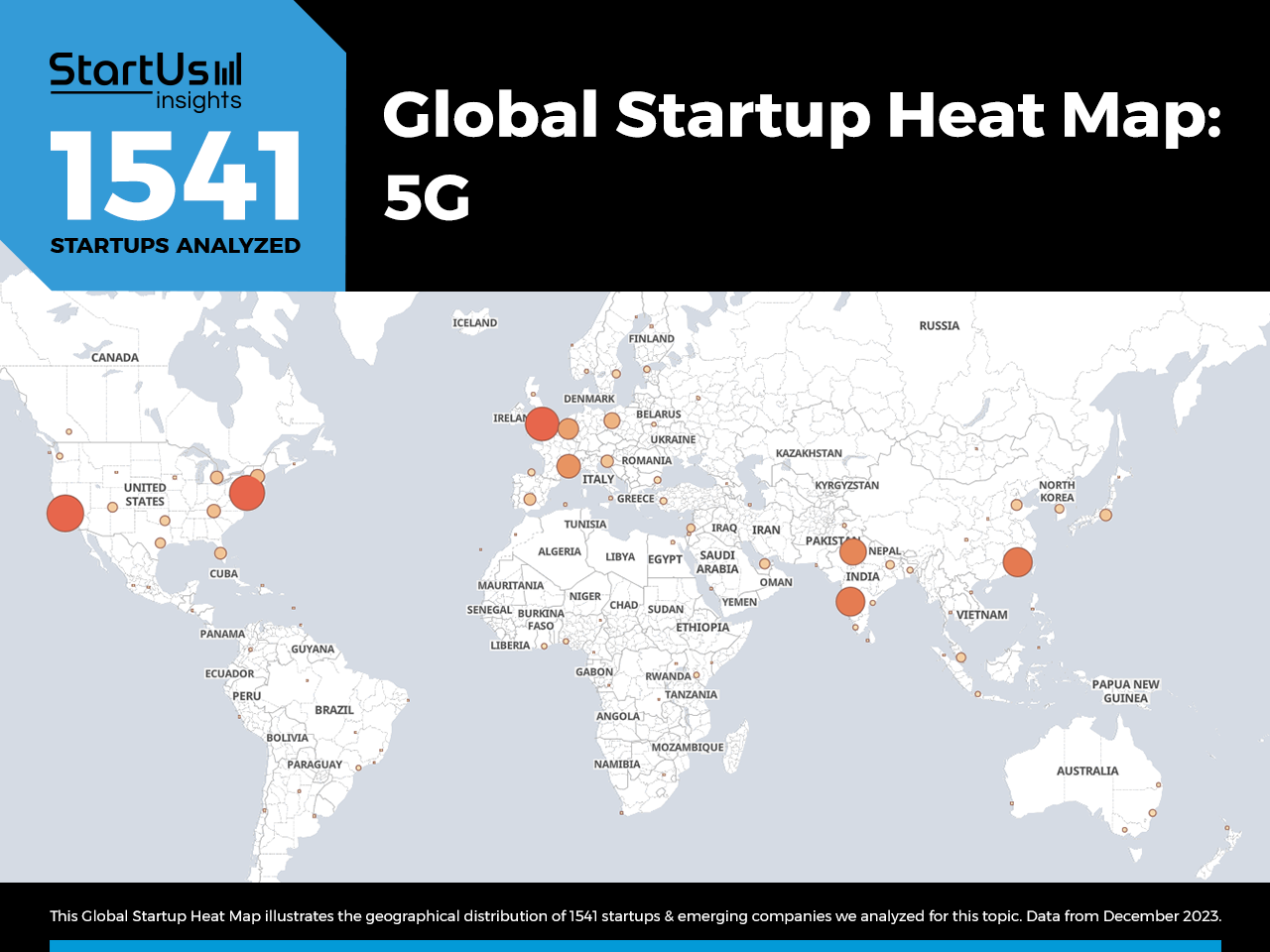


![10 Top AI Solutions for Telecom Operations [2025]](https://www.startus-insights.com/wp-content/uploads/2025/06/AI-Solutions-for-Telecom-Operations-SharedImg-StartUs-Insights-noresize-420x236.webp)


